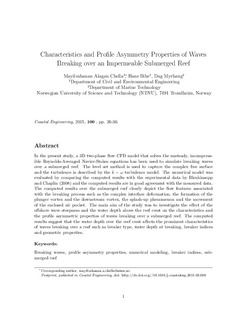| dc.contributor.author | Alagan Chella, Mayilvahanan | |
| dc.contributor.author | Bihs, Hans | |
| dc.contributor.author | Myrhaug, Dag | |
| dc.date.accessioned | 2019-03-04T12:05:47Z | |
| dc.date.available | 2019-03-04T12:05:47Z | |
| dc.date.created | 2015-03-25T12:08:23Z | |
| dc.date.issued | 2015 | |
| dc.identifier.citation | Coastal Engineering. 2015, 100 26-36. | nb_NO |
| dc.identifier.issn | 0378-3839 | |
| dc.identifier.uri | http://hdl.handle.net/11250/2588463 | |
| dc.description.abstract | In the present study, a 3D two-phase flow CFD model that solves the unsteady, incompressible Reynolds-Averaged Navier–Stokes equations has been used to simulate breaking waves over an impermeable submerged reef. The level set method is used to capture the complex free surface and the turbulence is described by the k − ω turbulence model. The numerical model was evaluated by comparing the computed results with the experimental data by Blenkinsopp and Chaplin (2008) and the computed results are in good agreement with the measured data. The computed results over the submerged reef clearly depict the flow features associated with the breaking process such as the complex interface deformation, the formation of the plunger vortex and the downstream vortex, the splash-up phenomenon and the movement of the enclosed air pocket. The main aim of the study was to investigate the effect of the offshore wave steepness and the water depth above the reef crest on the characteristics and the profile asymmetric properties of waves breaking over a submerged reef. The computed results suggest that the water depth over the reef crest affects the prominent characteristics of waves breaking over a reef such as breaker type, water depth at breaking, breaker indices and geometric properties. | nb_NO |
| dc.language.iso | eng | nb_NO |
| dc.publisher | Elsevier | nb_NO |
| dc.rights | Attribution-NonCommercial-NoDerivatives 4.0 Internasjonal | * |
| dc.rights.uri | http://creativecommons.org/licenses/by-nc-nd/4.0/deed.no | * |
| dc.title | Characteristics and Profile Asymmetry Properties of Waves Breaking over an Impermeable Submerged Reef | nb_NO |
| dc.type | Journal article | nb_NO |
| dc.type | Peer reviewed | nb_NO |
| dc.description.version | acceptedVersion | nb_NO |
| dc.source.pagenumber | 26-36 | nb_NO |
| dc.source.volume | 100 | nb_NO |
| dc.source.journal | Coastal Engineering | nb_NO |
| dc.identifier.doi | 10.1016/j.coastaleng.2015.03.008 | |
| dc.identifier.cristin | 1234348 | |
| dc.relation.project | Norges forskningsråd: 193823 | nb_NO |
| dc.relation.project | Notur/NorStore: NN9240K | nb_NO |
| dc.description.localcode | © 2015. This is the authors’ accepted and refereed manuscript to the article. Locked until 11 April 2017 due to copyright restrictions. This manuscript version is made available under the CC-BY-NC-ND 4.0 license http://creativecommons.org/licenses/by-nc-nd/4.0/ | nb_NO |
| cristin.unitcode | 194,64,91,0 | |
| cristin.unitcode | 194,64,20,0 | |
| cristin.unitname | Institutt for bygg- og miljøteknikk | |
| cristin.unitname | Institutt for marin teknikk | |
| cristin.ispublished | true | |
| cristin.fulltext | postprint | |
| cristin.qualitycode | 2 | |

